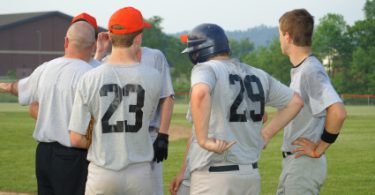If you are a pitcher looking to make a recruiting video, we have the perfect resource for you! While the article below will provide you with an overview of the information you need, our new online course, Creating a Successful DIY Recruiting Video, walks you through the process of creating a quality recruiting video and sending it out to college coaches from start to finish. The course provides information and insight from college coaches on:
- What to include in your video
- How to film your video
- How to appropriately incorporate measurable data into your video
- How to edit your video for maximum impact
- How to leverage your video to get recruited
Best of all? The course is FREE. Enroll today by clicking the button below!
Not interested? Read the overview article below.
For years, our college coaches surveys have shown an increased use of video for recruiting purposes. When we started the surveys, about 25% of coaches said they would recruit a player solely off of video. Now, a majority of coaches we speak with say they would commit a player based off of video and the right recommendations or information. With COVID-19, many programs are recruiting entirely off of video. Once we find the new normal of recruiting, you can bet that the reliance on video as a recruiting tool will remain at an all-time high. Simply put, having a skills video is a must in today’s day and age.
As we’ve explained before, making a skills video doesn’t have to be expensive or fancy. A smart phone and a teammate can get the job done. If you have access to a radar gun or other way to provide measurable data, even better! Don’t worry about being a professional film editor, coaches don't care and that's not what coaches are evaluating you for. Today's technology makes editing a breeze and it’s what’s included in the video that can really help you get recruited. Coaches want to see a glimpse of your athleticism, mechanics, and skills. They also almost universally say keep it short and forget the tacky background music. We asked the coaches who took part in our survey what they wanted to see on a pitcher’s skill video and their answers were almost identical, with only a few variations. Here are the essentials of what college coaches want to see in your video (which should be no more than 3 minutes long):
Best Skills First: Put your best skills first. You have 15-20 seconds to impress a coach. Don't let them turn your video off before getting to see your best skills.
Side Mechanics View: Video of all your pitches from the open (arm) side with a complete view of your delivery mechanics.
Behind Pitcher View: Coaches were split between wanting to see a view from behind the pitcher (with view of the flight of the ball) and from behind the catcher (with view of the flight of the ball). Our suggestion is to include both. Take video of all your pitches from behind the pitcher, slightly offset to the pitchers arm side so that you can see the delivery and the flight of the pitch. Include a radar gun reading in the frame for each pitch, if possible. It is also helpful for coaches if the camera angle doesn't change from pitch to pitch. Try to record each pitch from the same spot with as little camera movement as possible.
Behind the Catcher View: Also include a view from behind the catcher that captures the delivery and the flight of the ball. Video all your pitches from this view and include a radar gun reading in the frame for each pitch, if possible.
The Importance of Radar and Verifiable Data: You may not have access to a radar gun, but if you do, you should make sure it is included in your front and back views of each pitch. There is nothing more valuable to college coaches than verifiable information, and a radar gun reading in the frame of the pitch is almost as valuable as a coach witnessing the pitch in person. As one coach answered at the end of their response, “Also, PLEASE INCLUDE A [RADAR] GUN on the pen session if possible in the view of the live video.” Coaches trust the numbers, so if you can include a radar reading or other verifiable information about your pitches, it’s well worth your time and effort.
If you don't have access to a radar gun, check out @FlatgroundApp on Twitter and flatground.org. Rob Friedman (@PitchingNinja) is doing great things to help pitchers get help with video, access to radar guns, and free exposure. See if there is a partner facility in your area that is willing to provide you access to a radar gun!
Game Footage: Coaches have expressed mixed preferences between bullpen and game footage. If you have game footage, you should include it in addition to your bullpen video, but you don’t want a long recruiting video. The job of your video is to give coaches a snapshot of your ability and get them to follow up. You should be able to do this in 2-3 minutes or less. Keeping things short will allow you to post your videos on social media with ease to create more free exposure when you are ready. If you have extensive game footage, that’s great! Put together some of your better clips and let coaches know you have it if they want to see more.
Now it’s up to you. Find a smart phone, a teammate or two, and start filming. For more information on creating a skills video click here or sign up for our free online course, which will lead you through the process from start to finish. Enroll here!







